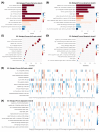Crebanine Induces Cell Death and Alters the Mitotic Process in Renal Cell Carcinoma In Vitro
- PMID: 40725144
- PMCID: PMC12295564
- DOI: 10.3390/ijms26146896
Crebanine Induces Cell Death and Alters the Mitotic Process in Renal Cell Carcinoma In Vitro
Abstract
Advanced renal cell carcinoma (RCC) has a poor prognosis; this drives the exploration of alternative systemic therapies to identify more effective treatment options. Recent research has revealed that crebanine, an alkaloid derivative of the Stephania genus, induces apoptotic effects in various cancers; however, a thorough investigation of the role of crebanine in RCC has not been conducted thus far. For this study, we evaluated tumor cell viability, clonogenicity, cell-cycle distributions, morphological changes, and cell mortality with the aim of exploring the antitumor effects of crebanine in RCC. Furthermore, we compared gene and protein expressions using RNA sequencing analysis and Western blotting. The findings indicated that crebanine significantly inhibited RCC colonies and caused G1-phase cell-cycle arrest with sub-G1-phase accumulation, thus leading to suppressed cell proliferation and cell death. In addition, Hoechst 33342 staining was used to observe apoptotic cells, which revealed chromatin condensation and a reduction in the nuclear volume associated with apoptosis. Further, gene ontology (GO) and Kyoto Encyclopedia of Genes and Genomes (KEGG) analysis indicated that differentially expressed genes are involved in the initiation of DNA replication, centrosome duplication, chromosome congression, and mitotic processes in the cell cycle along with signaling pathways, such as I-kappaB kinase/NF-kappaB signaling, Hippo signaling, and intrinsic apoptotic pathways. Consistent with GO and KEGG analyses, increased levels of cleaved caspase-3, cleaved caspase-7, and cleaved PARP, and decreased levels of cIAP1, BCL2, survivin, and claspin were observed. Finally, the expressions of G1/S phase transition cyclin D1, cyclin E/CDK2, and cyclin A2/CDK2 complexes were downregulated. Overall, these findings supported the potential of crebanine as an adjuvant therapy in RCC.
Keywords: Stephania venosa; aporphine alkaloid; kidney cancer; natural product; systemic treatment.
Conflict of interest statement
The authors declare that they have no known competing financial interests or personal relationships that could have influenced the work reported in this paper.
Figures





Similar articles
-
Hesperetin Inhibits Bladder Cancer Cell Proliferation and Promotes Apoptosis and Cycle Arrest by PI3K/AKT/FoxO3a and ER Stressmitochondria Pathways.Curr Med Chem. 2025;32(19):3879-3904. doi: 10.2174/0109298673283888231217174702. Curr Med Chem. 2025. PMID: 38357946
-
The effect of PDLIM7 on cell proliferation, migration, and drug sensitivity in clear cell renal cell carcinoma.Sci Rep. 2025 Jul 18;15(1):26111. doi: 10.1038/s41598-025-11495-9. Sci Rep. 2025. PMID: 40681591 Free PMC article.
-
Long non-coding RNA HOTTIP affects renal cell carcinoma progression by regulating autophagy via the PI3K/Akt/Atg13 signaling pathway.J Cancer Res Clin Oncol. 2019 Mar;145(3):573-588. doi: 10.1007/s00432-018-2808-0. Epub 2018 Dec 3. J Cancer Res Clin Oncol. 2019. PMID: 30511250 Free PMC article.
-
First-line therapy for adults with advanced renal cell carcinoma: a systematic review and network meta-analysis.Cochrane Database Syst Rev. 2023 May 4;5(5):CD013798. doi: 10.1002/14651858.CD013798.pub2. Cochrane Database Syst Rev. 2023. PMID: 37146227 Free PMC article.
-
Systemic treatments for metastatic cutaneous melanoma.Cochrane Database Syst Rev. 2018 Feb 6;2(2):CD011123. doi: 10.1002/14651858.CD011123.pub2. Cochrane Database Syst Rev. 2018. PMID: 29405038 Free PMC article.
References
-
- Gray R.E., Harris G.T. Renal Cell Carcinoma: Diagnosis and Management. Am. Fam. Physician. 2019;99:179–184. - PubMed
MeSH terms
Grants and funding
LinkOut - more resources
Full Text Sources
Medical
Research Materials

